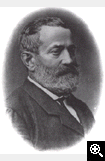|
|
|
| |
| |
Quintino Sella
| |



|
|
was born in Sella di Mosso (Biella) in 1827. Sella graduated in Hydraulic Engineering in 1847.
Appointed as student engineer at the Royal Body of Mines, he was sent by the Ministry of Interiors to Paris, where he folowed a 3-year class at the Ecole des Mines. Thanks to his relationships with H. de Sernamont, professor of Mineralogy in Paris, and thanks to other study stays in Germany and England (1851-1852), Sella got the bases of his scientific carreer, set mainly to crystallographic studies.
When he came back to Turin, Sella was appointed as professor of Practical geometry at the Technical Institute that, thanks to his interesting, was turned some time later into the Application School for Engineers (1859). All his scientific works in the field of the Theoretic and Morphologic Crystallography, applied both to the study of minerals and of organic and inorganic matters, were concentrated between 1854 and 1861. Let us remember the invention of Sella, that is the electRomegnetic grading machine to separate copper minerals from magnetite. Many of his works were published in the Memorie (Memories) of the Academy of Sciences of Turin, of which he was member since 1856.
In 1853 Sella assigned the Technical Institute with the Barelli Collection, in addition to four specimen of minerals from mines and quarries of Sardinian States, to reset and extend it even thanks to the contribution of his private collection, reaching in this way eighteen thousand units.
In 1860 Sella got the chair of Mineralogy at the Application School for Engineers, but he dismissed quite soon due to political engagements.
Famous statist and economist, Sella was a minister under Cavour, Rattazzi, La Marmora and Lanza. He settled the the Italian Alpine Club on 20th October 1863. In 1870 Sella was among people who wanted Rome as capital town of Italy.
He died in Biella on 14th March 1884, whereas he was president of the National Academy of Lincei, of which he was a very active renewer.
|
| |
|
|

